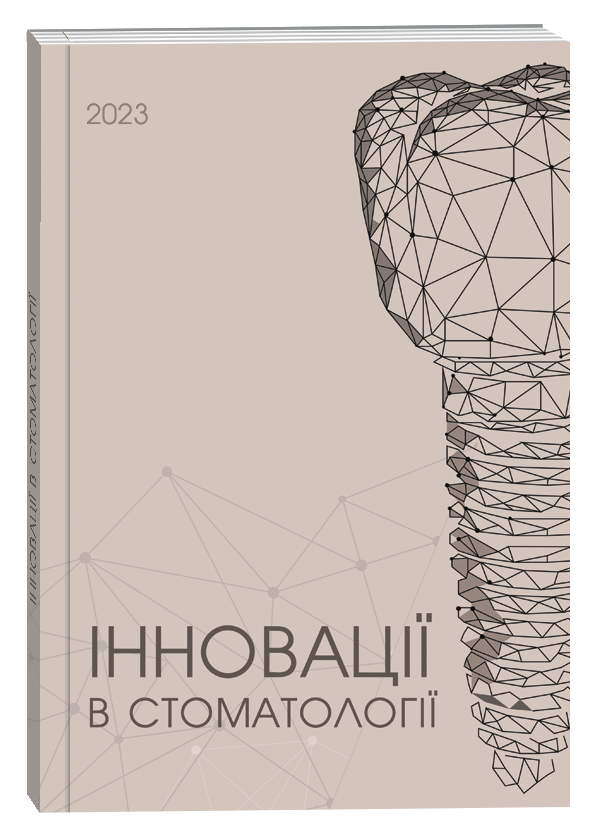PREVALENCE OF CHRONIC CATARRHAL GINGIVITIS IN CHILDREN WITH NEUROPSYCHIATRIC DISORDERS
DOI:
https://doi.org/10.35220/2523-420X/2023.4.8Keywords:
chronic catarrhal gingivitis, mental retardation, down syndrome, autism, prevalence, childrenAbstract
Purpose. To study the prevalence and features of the course of chronic catarrhal gingivitis in children against the background of neuropsychiatric disorders. Material and methods. To achieve this goal, 108 children aged 13–18 years with neuropsychiatric disorders (the main group) and 86 practically healthy children (the comparison group) were examined. Results. The results of the study showed that chronic catarrhal gingivitis (CCG) was found in the children of the main group in 75.79±5.13%, which is 1.6 times more than in the children of the comparison group (47.15±4.02%, p<0.05). It was found that in children with mental retardation, the prevalence of CCG was the highest and amounted to 90.42±5.96%, which is almost twice as much as compared to the comparison group (p˂0.05), in children with Down syndrome ‒ by 1.6 times (р˂0.05), in children with autism – almost 1.3 times (р˂0.05). Moreover, in children with delayed mental development, the frequency of CCG was the highest, in children with Down syndrome the prevalence of CCG was almost 1.2 times lower compared to children with mental retardation (p<0,05), and in children with autism ‒ almost 1.5 times (p<0,05). The prevalence of CCG in children with autism was 1.2 times lower than in children with Down syndrome (p<0,05). It was found that mild severity of CCG was most often diagnosed among children aged 13–15 and 16–18 years with autism, while the average severity of CCG at the age of 13–15 years was more often found in children with Down syndrome, and in 16–18 years ‒ in children with mental retardation. The severe form of CCG was determined in more 13–15-year-old children with mental retardation, but at the age of 16–18 years this form was more often diagnosed in children with Down syndrome. Conclusion. So, children with various neuropsychiatric disorders have a high prevalence of chronic catarrhal gingivitis. The frequency and severity of the course of chronic catarrhal gingivitis depends on the form of pathology.
References
Каськова Л.Ф., Попик К.М., Уласевич Л.П., Андріянова О.Ю., Кулай О.О. Вікові відмінності показників карієсу постійних зубів у дітей 6–16 років. Вісник проблем біології і медицини. 2019. №1 (149). С. 353–357.
Трубка І.О., Парпалей К.А., Корнієнко Л.В. Ранній карієс тимчасових зубів у дітей: ризики, профілактика, лікування. Медична газета «Здоров’я України 21 сторіччя». 2019 Січ; 2(447): 38–39. URL: https://healthua.com/newspaper/med_gaz_zu/40278-medichnagazeta-zdorovya-ukrani-21-storchchya-1-446-schen-2019-r,
Клітинська О., Зорівчак Т. Ретроспективний аналіз поширеності карієсу тимчасових зубів та його ускладнень у дітей Закарпатської області. Вісник стоматології. 2022. Т. 120, № 3. С. 98–103.
Котельбан А.В., Ратушняк А.І. Пародонтологічний статус у дітей Буковини. Вісник стоматології. 2022. Т. 45, №3 (120). С. 104–108.
Змарко Ю.К. Клінічно-патогенетичне обґрунтування використання нанотехнологічного гелю у комплексному лікуванні дітей із хронічним катаральним гінгівітом : автореф. дис. ... канд. мед. наук: 14.01.22. Львів, 2018. 20 c.
Хоменко Л.О., Остапко О.І., Біденко Н.В., Голубєва І.М., Воєвода О.О., Дуда О. В. Вплив стану організму на стоматологічні захворювання у дітей та підлітків. Медична наука України. 2016. Т. 12, № 1–2. С. 58–63.
Смоляр Н.І., Боднарук Н.І., Лисак Т.Ю., Ган І.В. Оцінка ураженості карієсом тимчасових зубів у дітей із соматичною патологією (огляд літератури). Український стоматологічний альманах. 2020. № 3. С. 53–61.
Godovanets O. I., Kitsak T. S. The periodontal tissue state in children of the juvenile age taking into consideration the general somatic factor. Клінічна та експериментальна патологія. 2022. Vol. 21, № 2 (80). P. 45–49
Чухрай Н.Л., Мусій-Семенців Х.Г., Дутко Г.З., Стадник У.О., Лисак Т.Ю. Клінічна оцінка ефективності лікування хронічного катарального гінгівіту в дітей з олігофренією. Клінічна стоматологія. 2022. № 1. С. 38–45.
Назарян Р.С., Іскоростенська О.В. Показники гігієнічного статусу порожнини рота у дітей із синдромом Дауна. Медицина сьогодні і завтра. 2016. № 1. С. 105–109.
Ципан С.Б., Якубова І.І., Бардавіль Д.І., та ін. Поширеність захворювань тканин пародонта в дітейз розладами аутистичного спектру. Сучасна стоматологія. 2020. № 1. С. 78–85.
Приймак Х.В., Зорій І.А., Біденко Н.В. Стоматологічний статус у дітей з дитячим церебральним паралічем. Терапевтика. 2022. Т. 3, № 1. С. 35–40.
Скрипник Ю.В., Якубова І.І., Ісаєва Н.С. Поширеність карієсу зубів у дітей із затримкою психічного розвитку. Профілактична та дитяча стоматологія. 2016. № 1. С. 19–27.
Sohal AP. Oral health in children with cerebral palsy: A pediatric neurologist’s perspective. Asian J Oral Health Allied Sci. 2020. № 10(8). Р. 1–4.
Дутко Г.З. Взаємозв’язок захворювань пародонта з психосоматичною патологією у дітей. Клінічна стоматологія. 2015. № 3–4. С. 148.
Alkan A., Cakmak O., Yilmaz S., et al. Relationship between psychological factors and oral health status and behaviours. Oral Health Prev. Dent. 2015. Vol.13. P. 331–339. https://doi.org/10.3290/j.ohpd.a32679.
Choi J., Price J., Ryder S., et al. Prevalence of dental disorders among people with mental illness: An umbrella review. Australian & New Zealand Journal of Psychiatry. 2022. Vol.56 (Iss.8). Р. 949–963. https://doi.org/10.1177/00048674211042239.
Solanki J., Gupta S., Arya A. Dental caries and periodontal status of mentally handicapped institutilized children. J. Clin. Diagn. Res. 2014. Vol. 8 (Iss.7). P. 25–27. https://doi.org/10.7860/JCDR/2014/8983.4557.








